|
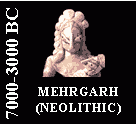 Mehrgarh civilization in the foot hills of Bolan Pass and arid Kachi plain of Balochistan province of Pakistan is the the earliest known farming settlement in South Asia, which once thrived around 7000 BC until the end of Indus valley civilization. Neolithic Mehrgarh consists of four mounds. The remains show that around 5100 BC, the Mehrgarh inhabitants constructed mud-brick structures. The remains of a large town spread over some 170 acres makes it the largest in the ancient world, being five times the size of the contemporary
Catal Huyuk site in Turkey which has been called the largest Neolithic site in the Near East. It may be added that the entire population of Egypt was around 30,000 persons around 6000 BC, almost same as of Mehrgarh alone. Mehrgarh civilization in the foot hills of Bolan Pass and arid Kachi plain of Balochistan province of Pakistan is the the earliest known farming settlement in South Asia, which once thrived around 7000 BC until the end of Indus valley civilization. Neolithic Mehrgarh consists of four mounds. The remains show that around 5100 BC, the Mehrgarh inhabitants constructed mud-brick structures. The remains of a large town spread over some 170 acres makes it the largest in the ancient world, being five times the size of the contemporary
Catal Huyuk site in Turkey which has been called the largest Neolithic site in the Near East. It may be added that the entire population of Egypt was around 30,000 persons around 6000 BC, almost same as of Mehrgarh alone.
 Stone sickles found at Mehrgarh point towards wheat cultivation. Conch shells from the Arabian Sea (500 km distant) and lapis lazuli from Badakshan dating back to period after 5000 BC indicate trade networks. By 3500 BC Mehrgarh had grown into an important regional craft center. Pieces of painted pottery and ornaments (right) and figurines representing both humans and animals have also been discovered recently from the site. In what could be one of the earliest examples of dentistry,
scientists at the University of Missouri-Columbia in the United
States have found tiny, perfectly rounded holes in teeth found in
Mehrgarh, which they suspect were drilled to repair tooth decay. Stone sickles found at Mehrgarh point towards wheat cultivation. Conch shells from the Arabian Sea (500 km distant) and lapis lazuli from Badakshan dating back to period after 5000 BC indicate trade networks. By 3500 BC Mehrgarh had grown into an important regional craft center. Pieces of painted pottery and ornaments (right) and figurines representing both humans and animals have also been discovered recently from the site. In what could be one of the earliest examples of dentistry,
scientists at the University of Missouri-Columbia in the United
States have found tiny, perfectly rounded holes in teeth found in
Mehrgarh, which they suspect were drilled to repair tooth decay.
 The habitation at Mehrgarh has been divided into seven periods, the first being the Pre-Pottery Neolithic period that dates to 7000 BC or even earlier. The site was abandoned between 2000 and 2500 BC during a period of contact with the Indus Civilization and then reused as a burial ground for some time after 2000 BC.
It would not be wrong to conclude then that the Indus Valley civilization began neither in Mohenjo-Daro nor Harappa but at Mehrgarh, as the archeologists in the 1960s linked clues of Harappan genesis to Mehrgarh, when they found early indications of Harappan styles, specially the similarities in pottery designs. The habitation at Mehrgarh has been divided into seven periods, the first being the Pre-Pottery Neolithic period that dates to 7000 BC or even earlier. The site was abandoned between 2000 and 2500 BC during a period of contact with the Indus Civilization and then reused as a burial ground for some time after 2000 BC.
It would not be wrong to conclude then that the Indus Valley civilization began neither in Mohenjo-Daro nor Harappa but at Mehrgarh, as the archeologists in the 1960s linked clues of Harappan genesis to Mehrgarh, when they found early indications of Harappan styles, specially the similarities in pottery designs.
|
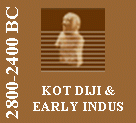 Many
believe that Indus Valley civilization has been the oldest civilization that
flourished in the Indian subcontinent. Mehrgarh Civilization, though broke
this myth, there were yet other surprises. The excavations at Kot Diji, Sind
Pakistan has revealed that before Indus Valley, there existed a civilization
that is pre-Harappa and Harappa period occupations (ca. 3200-2000 BC). Many
believe that Indus Valley civilization has been the oldest civilization that
flourished in the Indian subcontinent. Mehrgarh Civilization, though broke
this myth, there were yet other surprises. The excavations at Kot Diji, Sind
Pakistan has revealed that before Indus Valley, there existed a civilization
that is pre-Harappa and Harappa period occupations (ca. 3200-2000 BC).
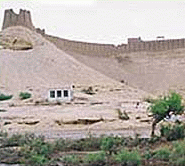 A
forty-feet high archaeological site reflects the grandeur of the past and
craftsmanship of those people. Historians and archaeologists are of the
opinion that Indus Valley Civilization borrowed or developed some of the
basic elements of life and culture from the civilization that was thriving
at Kot Diji.
Read More. A
forty-feet high archaeological site reflects the grandeur of the past and
craftsmanship of those people. Historians and archaeologists are of the
opinion that Indus Valley Civilization borrowed or developed some of the
basic elements of life and culture from the civilization that was thriving
at Kot Diji.
Read More.
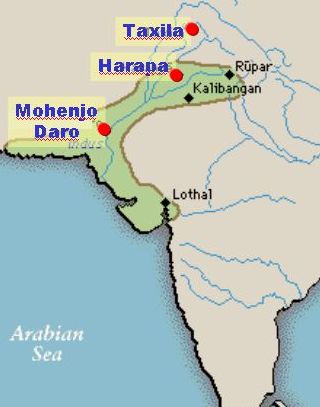 It is believed that with the destruction
of fortified settlement on the site of Kot Diji somewhere between 2800-2500
BC, in what is said to be two separate burning events, the Indus Valley
civilization settled in parts of lower Sind. Pottery at Mehrgarh begins to
resemble a general Harappan fine geometric wheel-thrown tradition. Clay
female figurines mark this period, possible precursors to the figurines of
the later Indus society. It is believed that with the destruction
of fortified settlement on the site of Kot Diji somewhere between 2800-2500
BC, in what is said to be two separate burning events, the Indus Valley
civilization settled in parts of lower Sind. Pottery at Mehrgarh begins to
resemble a general Harappan fine geometric wheel-thrown tradition. Clay
female figurines mark this period, possible precursors to the figurines of
the later Indus society.
Although the pre-Indus and early Indus settlements of the foothills to the
northwest of the Indus valley are best known, several meters of unexcavated
pre-Indus archaeological remains at the principal sites of Mohenjo-Daro and
Harappa suggest we do not know a great deal about contemporaneous
developments on the flood plain.
The Indus Valley settlements are spread
along the Indus River and the Ghaggar-Hakra river in what is now Pakistan.
These settlements can be found as far south as Mumbai, or Delh in esti, to
the west to the Iranian border, and as far north as the Himalayas. Among the
settlements were the major urban centers of Harappa and Mohenjo-daro, as
well as Dholavira, Ganweriwala, Lothal, and Rakhigarhi. At its peak, the
Indus Civilization may have had a population of well over five million. |
|
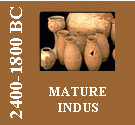 The
later period of Indus Valley civilization from 2400-1800 BC, there is marked
improvement in system of weights and measures, identical sized fire-backed bricks
and standard writing
system. So far about 700 sites have been discovered relating to the Indus
Valley. Harappa, Mohenjo-Daro, and Ganweiwala are the larger sites of all
spread over some 120
hectares and constructed like a citadel with separate public
and residential areas, interspersed with road network. Extensive sewage and
water drainage systems also are unique to Indus settlements. The
later period of Indus Valley civilization from 2400-1800 BC, there is marked
improvement in system of weights and measures, identical sized fire-backed bricks
and standard writing
system. So far about 700 sites have been discovered relating to the Indus
Valley. Harappa, Mohenjo-Daro, and Ganweiwala are the larger sites of all
spread over some 120
hectares and constructed like a citadel with separate public
and residential areas, interspersed with road network. Extensive sewage and
water drainage systems also are unique to Indus settlements.
 Unfortunately despite discovery of its remains in 1922 by the British
archaeologist Sir John Marshall, the Indus civilization is still poorly understood. Its writing system,
read right-to-left, and only occurs in short texts of a few signs (usually
less than 10, and never above 17)) remains un-deciphered (2500 texts have
been discovered, but only 400 signs deciphered so far), and the causes of its sudden disappearance, beginning around 1900 BC have never been dug into. Hence no one knows what these people called themselves. All of these facts stand in stark contrast to what is known about its contemporaries, Mesopotamia and ancient Egypt. Unfortunately despite discovery of its remains in 1922 by the British
archaeologist Sir John Marshall, the Indus civilization is still poorly understood. Its writing system,
read right-to-left, and only occurs in short texts of a few signs (usually
less than 10, and never above 17)) remains un-deciphered (2500 texts have
been discovered, but only 400 signs deciphered so far), and the causes of its sudden disappearance, beginning around 1900 BC have never been dug into. Hence no one knows what these people called themselves. All of these facts stand in stark contrast to what is known about its contemporaries, Mesopotamia and ancient Egypt.

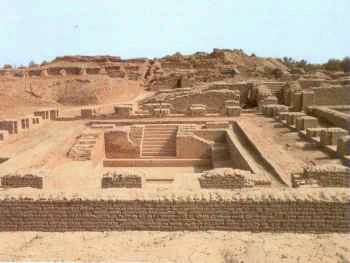
|
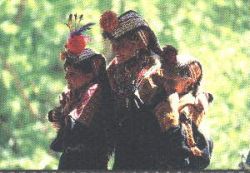 The Kafir "Kalash:
The
Persian emperor Cyrus the Great conquered part of the Punjab somewhere around 530 BC, while Alexander the Great conquered area up to Multan before his own troops forced him to turn back in 332 BC. Some believe that the "Kafir Kalash" tribe in northern areas of Pakistan (Chitral) are the decendants of those Greek soldiers who married the locals and left their imprints behind. The "Kalash Country" is spread over three Valleys; Bomboret, Birir and Rumbur. The Kafir "Kalash:
The
Persian emperor Cyrus the Great conquered part of the Punjab somewhere around 530 BC, while Alexander the Great conquered area up to Multan before his own troops forced him to turn back in 332 BC. Some believe that the "Kafir Kalash" tribe in northern areas of Pakistan (Chitral) are the decendants of those Greek soldiers who married the locals and left their imprints behind. The "Kalash Country" is spread over three Valleys; Bomboret, Birir and Rumbur.
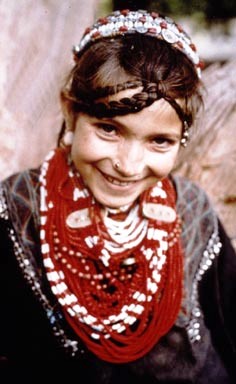 The the Kalash women wear long black robes and attractive headgear, skillfully made entirely of
cowry's shells and buttons. Kalash keep their dead fully dressed in open coffins. The Nuristani carvings, handicrafts and motifs used to decorate the houses are a unique representation of their culture.
The Kalash have always fascinated anthropologists and historians by their obscure origins, colourful
festivals, and curious customs and rituals. The the Kalash women wear long black robes and attractive headgear, skillfully made entirely of
cowry's shells and buttons. Kalash keep their dead fully dressed in open coffins. The Nuristani carvings, handicrafts and motifs used to decorate the houses are a unique representation of their culture.
The Kalash have always fascinated anthropologists and historians by their obscure origins, colourful
festivals, and curious customs and rituals.
These days, however, trends are changing and some Kafirs are converting to Islam, leaving their age old traditions and customs. For some it is beginning of a demise of an old civilization - for others it is dawn of a new life.
|
|
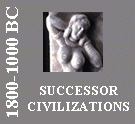 Gandhara
and
Buddhism are two civilizations
that thrived in the northern parts of Pakistan from around the Vedic times
and Greco-Buddhism is considered to be the cultural syncretism between the
culture of Classical Greece and Buddhism, which developed over a period of
close to 800 years in the area corresponding to modern-day Afghanistan and
Pakistan, between the 4th century BCE and the 5th century CE. Greco-Buddhism
influenced the artistic (and, possibly, conceptual) development of Buddhism,
before it was adopted by Central and Northeastern Asia from the 1st century
CE, ultimately spreading to China, Korea and Japan. Gandhara
and
Buddhism are two civilizations
that thrived in the northern parts of Pakistan from around the Vedic times
and Greco-Buddhism is considered to be the cultural syncretism between the
culture of Classical Greece and Buddhism, which developed over a period of
close to 800 years in the area corresponding to modern-day Afghanistan and
Pakistan, between the 4th century BCE and the 5th century CE. Greco-Buddhism
influenced the artistic (and, possibly, conceptual) development of Buddhism,
before it was adopted by Central and Northeastern Asia from the 1st century
CE, ultimately spreading to China, Korea and Japan.
 "Gandhara" - the ancient name of the present day NWFP province of Pakistan is said to be the second home of
Buddhism (after Bihar - India, where Buddha was born). Emperor Ashoka who ruled Maurya Dynasty somewhere in 270-230 BC was a
staunch supporter of Buddhism. With the spread of Buddhism, monasteries sprang over in the length and breadth of present day Pakistan. The Swat Valley
in present day Pakistan is the ancient Buddhist land of "Udeyana" which served as a threshold to western Asia and China. Once fourteen hundred monasteries flourished here at one time. Taxila is also one of the strongholds of
Buddhism. It is mentioned as a territory of the Great Achaemenian Empire of Persia in the 6th century B.C. in inscriptions of Darius the Great at Behistun and is famous for the rare specimens of stucco from the Gandhara period excavated from Sirkap and various Buddhist Stupas and Monasteries.
The Dharmarajika stupa in Taxila, built by Ashoka contains a relic of Buddhism. Taxila came to an inglorious end around 450 A.D. when it was ransacked by hordes of White Huns. "Gandhara" - the ancient name of the present day NWFP province of Pakistan is said to be the second home of
Buddhism (after Bihar - India, where Buddha was born). Emperor Ashoka who ruled Maurya Dynasty somewhere in 270-230 BC was a
staunch supporter of Buddhism. With the spread of Buddhism, monasteries sprang over in the length and breadth of present day Pakistan. The Swat Valley
in present day Pakistan is the ancient Buddhist land of "Udeyana" which served as a threshold to western Asia and China. Once fourteen hundred monasteries flourished here at one time. Taxila is also one of the strongholds of
Buddhism. It is mentioned as a territory of the Great Achaemenian Empire of Persia in the 6th century B.C. in inscriptions of Darius the Great at Behistun and is famous for the rare specimens of stucco from the Gandhara period excavated from Sirkap and various Buddhist Stupas and Monasteries.
The Dharmarajika stupa in Taxila, built by Ashoka contains a relic of Buddhism. Taxila came to an inglorious end around 450 A.D. when it was ransacked by hordes of White Huns.
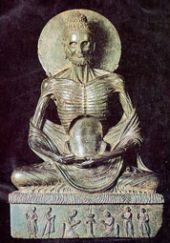 In the 15th century, the Buddhist culture of the north-west was destroyed by the invasion of White Huns, and
monasteries were burnt and cultural life started to extinct. From early 4th to 6th century, the famous Gupta Dynasty struggled to withstand the Huns, but finally capitulated. During Guptas, the Hinduism gained its importance, the effects of which started being felt in Punjab and Sind as well. Even after the advent of Islam in the 7th century, both Hinduism and Buddhism continued to flourish owing to liberal policies of the Arabs. The peaceful co-existence lasted well into 10th century AD. Some of the Buddhist relics found in Sind date back to 11th century AD. As the spread of
Islam became pronounced, the artists/sculpturists who had been associated with statues and engravings diverted to Islamic architecture and designs. In the 15th century, the Buddhist culture of the north-west was destroyed by the invasion of White Huns, and
monasteries were burnt and cultural life started to extinct. From early 4th to 6th century, the famous Gupta Dynasty struggled to withstand the Huns, but finally capitulated. During Guptas, the Hinduism gained its importance, the effects of which started being felt in Punjab and Sind as well. Even after the advent of Islam in the 7th century, both Hinduism and Buddhism continued to flourish owing to liberal policies of the Arabs. The peaceful co-existence lasted well into 10th century AD. Some of the Buddhist relics found in Sind date back to 11th century AD. As the spread of
Islam became pronounced, the artists/sculpturists who had been associated with statues and engravings diverted to Islamic architecture and designs.
The interaction
between Hellenistic Greece and Buddhism started when Alexander conquered
Asia Minor, the Achaemenid Empire and ancient Pakistan in 334 BCE, defeating
Porus at the Battle of the Hydaspes (near modern-day Jhelum, Pakistan) and
conquering much of the Punjab. Alexander's troops refused to go beyond the
Beas river — which today runs along part of the Indo-Pakistan border.
Alexander created garrisons for his troops in his new territories, and
founded several cities in the areas of the Oxus, Arachosia, and Bactria, and
Macedonian/Greek settlements in
Gandhara in general area Taxila of present day Pakistan. One can find traces
of Alexander's imprints along the Khyber Pass — a geographical passageway
south of the Himalayas and the Hindu Kush mountains — and the Bolan Pass, on
a trade route connecting Drangiana, Arachosia and other Persian and Central
Asia areas to the lower Indus plain. It is through these regions that most
of the interaction between India and Central Asia took place, generating
intense cultural exchange and trade.
After Alexander's death on June 10, 323 BCE, his generals founded their own
kingdoms in Asia Minor and Central Asia. General Seleucus set up the
Seleucid Kingdom, which extended as far as India. Later, the Eastern part of
the Seleucid Kingdom broke away to form the Greco-Bactrian Kingdom
(3rd–2nd century BCE), followed by the Indo-Greek Kingdom (2nd–1st century
BCE), and later still by the Kushan Empire (1st–3rd century CE). The
interaction of Greek and Buddhist cultures continued over several centuries
until it ended in the 5th century CE with the invasions of the White Huns,
and later the expansion of Islam. |

 Mehrgarh civilization in the foot hills of Bolan Pass and arid Kachi plain of Balochistan province of Pakistan is the the earliest known farming settlement in South Asia, which once thrived around 7000 BC until the end of Indus valley civilization. Neolithic Mehrgarh consists of four mounds. The remains show that around 5100 BC, the Mehrgarh inhabitants constructed mud-brick structures. The remains of a large town spread over some 170 acres makes it the largest in the ancient world, being five times the size of the contemporary
Catal Huyuk site in Turkey which has been called the largest Neolithic site in the Near East. It may be added that the entire population of Egypt was around 30,000 persons around 6000 BC, almost same as of Mehrgarh alone.
Mehrgarh civilization in the foot hills of Bolan Pass and arid Kachi plain of Balochistan province of Pakistan is the the earliest known farming settlement in South Asia, which once thrived around 7000 BC until the end of Indus valley civilization. Neolithic Mehrgarh consists of four mounds. The remains show that around 5100 BC, the Mehrgarh inhabitants constructed mud-brick structures. The remains of a large town spread over some 170 acres makes it the largest in the ancient world, being five times the size of the contemporary
Catal Huyuk site in Turkey which has been called the largest Neolithic site in the Near East. It may be added that the entire population of Egypt was around 30,000 persons around 6000 BC, almost same as of Mehrgarh alone.
 Stone sickles found at Mehrgarh point towards wheat cultivation. Conch shells from the Arabian Sea (500 km distant) and lapis lazuli from Badakshan dating back to period after 5000 BC indicate trade networks. By 3500 BC Mehrgarh had grown into an important regional craft center. Pieces of painted pottery and ornaments (right) and figurines representing both humans and animals have also been discovered recently from the site. In what could be one of the earliest examples of dentistry,
scientists at the University of Missouri-Columbia in the United
States have found tiny, perfectly rounded holes in teeth found in
Mehrgarh, which they suspect were drilled to repair tooth decay.
Stone sickles found at Mehrgarh point towards wheat cultivation. Conch shells from the Arabian Sea (500 km distant) and lapis lazuli from Badakshan dating back to period after 5000 BC indicate trade networks. By 3500 BC Mehrgarh had grown into an important regional craft center. Pieces of painted pottery and ornaments (right) and figurines representing both humans and animals have also been discovered recently from the site. In what could be one of the earliest examples of dentistry,
scientists at the University of Missouri-Columbia in the United
States have found tiny, perfectly rounded holes in teeth found in
Mehrgarh, which they suspect were drilled to repair tooth decay.
 The habitation at Mehrgarh has been divided into seven periods, the first being the Pre-Pottery Neolithic period that dates to 7000 BC or even earlier. The site was abandoned between 2000 and 2500 BC during a period of contact with the Indus Civilization and then reused as a burial ground for some time after 2000 BC.
It would not be wrong to conclude then that the Indus Valley civilization began neither in Mohenjo-Daro nor Harappa but at Mehrgarh, as the archeologists in the 1960s linked clues of Harappan genesis to Mehrgarh, when they found early indications of Harappan styles, specially the similarities in pottery designs.
The habitation at Mehrgarh has been divided into seven periods, the first being the Pre-Pottery Neolithic period that dates to 7000 BC or even earlier. The site was abandoned between 2000 and 2500 BC during a period of contact with the Indus Civilization and then reused as a burial ground for some time after 2000 BC.
It would not be wrong to conclude then that the Indus Valley civilization began neither in Mohenjo-Daro nor Harappa but at Mehrgarh, as the archeologists in the 1960s linked clues of Harappan genesis to Mehrgarh, when they found early indications of Harappan styles, specially the similarities in pottery designs.
 Many
believe that Indus Valley civilization has been the oldest civilization that
flourished in the Indian subcontinent. Mehrgarh Civilization, though broke
this myth, there were yet other surprises. The excavations at Kot Diji, Sind
Pakistan has revealed that before Indus Valley, there existed a civilization
that is pre-Harappa and Harappa period occupations (ca. 3200-2000 BC).
Many
believe that Indus Valley civilization has been the oldest civilization that
flourished in the Indian subcontinent. Mehrgarh Civilization, though broke
this myth, there were yet other surprises. The excavations at Kot Diji, Sind
Pakistan has revealed that before Indus Valley, there existed a civilization
that is pre-Harappa and Harappa period occupations (ca. 3200-2000 BC).
 A
forty-feet high archaeological site reflects the grandeur of the past and
craftsmanship of those people. Historians and archaeologists are of the
opinion that Indus Valley Civilization borrowed or developed some of the
basic elements of life and culture from the civilization that was thriving
at Kot Diji.
A
forty-feet high archaeological site reflects the grandeur of the past and
craftsmanship of those people. Historians and archaeologists are of the
opinion that Indus Valley Civilization borrowed or developed some of the
basic elements of life and culture from the civilization that was thriving
at Kot Diji.
 It is believed that with the destruction
of fortified settlement on the site of Kot Diji somewhere between 2800-2500
BC, in what is said to be two separate burning events, the Indus Valley
civilization settled in parts of lower Sind. Pottery at Mehrgarh begins to
resemble a general Harappan fine geometric wheel-thrown tradition. Clay
female figurines mark this period, possible precursors to the figurines of
the later Indus society.
It is believed that with the destruction
of fortified settlement on the site of Kot Diji somewhere between 2800-2500
BC, in what is said to be two separate burning events, the Indus Valley
civilization settled in parts of lower Sind. Pottery at Mehrgarh begins to
resemble a general Harappan fine geometric wheel-thrown tradition. Clay
female figurines mark this period, possible precursors to the figurines of
the later Indus society.  The
later period of Indus Valley civilization from 2400-1800 BC, there is marked
improvement in system of weights and measures, identical sized fire-backed bricks
and standard writing
system. So far about 700 sites have been discovered relating to the Indus
Valley. Harappa, Mohenjo-Daro, and Ganweiwala are the larger sites of all
spread over some 120
hectares and constructed like a citadel with separate public
and residential areas, interspersed with road network. Extensive sewage and
water drainage systems also are unique to Indus settlements.
The
later period of Indus Valley civilization from 2400-1800 BC, there is marked
improvement in system of weights and measures, identical sized fire-backed bricks
and standard writing
system. So far about 700 sites have been discovered relating to the Indus
Valley. Harappa, Mohenjo-Daro, and Ganweiwala are the larger sites of all
spread over some 120
hectares and constructed like a citadel with separate public
and residential areas, interspersed with road network. Extensive sewage and
water drainage systems also are unique to Indus settlements.



 The the Kalash women wear long black robes and attractive headgear, skillfully made entirely of
cowry's shells and buttons. Kalash keep their dead fully dressed in open coffins. The Nuristani carvings, handicrafts and motifs used to decorate the houses are a unique representation of their culture.
The Kalash have always fascinated anthropologists and historians by their obscure origins, colourful
festivals, and curious customs and rituals.
The the Kalash women wear long black robes and attractive headgear, skillfully made entirely of
cowry's shells and buttons. Kalash keep their dead fully dressed in open coffins. The Nuristani carvings, handicrafts and motifs used to decorate the houses are a unique representation of their culture.
The Kalash have always fascinated anthropologists and historians by their obscure origins, colourful
festivals, and curious customs and rituals.  Gandhara
and
Buddhism are two civilizations
that thrived in the northern parts of Pakistan from around the Vedic times
and Greco-Buddhism is considered to be the cultural syncretism between the
culture of Classical Greece and Buddhism, which developed over a period of
close to 800 years in the area corresponding to modern-day Afghanistan and
Pakistan, between the 4th century BCE and the 5th century CE. Greco-Buddhism
influenced the artistic (and, possibly, conceptual) development of Buddhism,
before it was adopted by Central and Northeastern Asia from the 1st century
CE, ultimately spreading to China, Korea and Japan.
Gandhara
and
Buddhism are two civilizations
that thrived in the northern parts of Pakistan from around the Vedic times
and Greco-Buddhism is considered to be the cultural syncretism between the
culture of Classical Greece and Buddhism, which developed over a period of
close to 800 years in the area corresponding to modern-day Afghanistan and
Pakistan, between the 4th century BCE and the 5th century CE. Greco-Buddhism
influenced the artistic (and, possibly, conceptual) development of Buddhism,
before it was adopted by Central and Northeastern Asia from the 1st century
CE, ultimately spreading to China, Korea and Japan. "Gandhara" - the ancient name of the present day NWFP province of Pakistan is said to be the second home of
Buddhism (after Bihar - India, where Buddha was born). Emperor Ashoka who ruled Maurya Dynasty somewhere in 270-230 BC was a
staunch supporter of Buddhism. With the spread of Buddhism, monasteries sprang over in the length and breadth of present day Pakistan. The Swat Valley
in present day Pakistan is the ancient Buddhist land of "Udeyana" which served as a threshold to western Asia and China. Once fourteen hundred monasteries flourished here at one time. Taxila is also one of the strongholds of
Buddhism. It is mentioned as a territory of the Great Achaemenian Empire of Persia in the 6th century B.C. in inscriptions of Darius the Great at Behistun and is famous for the rare specimens of stucco from the Gandhara period excavated from Sirkap and various Buddhist Stupas and Monasteries.
The Dharmarajika stupa in Taxila, built by Ashoka contains a relic of Buddhism. Taxila came to an inglorious end around 450 A.D. when it was ransacked by hordes of White Huns.
"Gandhara" - the ancient name of the present day NWFP province of Pakistan is said to be the second home of
Buddhism (after Bihar - India, where Buddha was born). Emperor Ashoka who ruled Maurya Dynasty somewhere in 270-230 BC was a
staunch supporter of Buddhism. With the spread of Buddhism, monasteries sprang over in the length and breadth of present day Pakistan. The Swat Valley
in present day Pakistan is the ancient Buddhist land of "Udeyana" which served as a threshold to western Asia and China. Once fourteen hundred monasteries flourished here at one time. Taxila is also one of the strongholds of
Buddhism. It is mentioned as a territory of the Great Achaemenian Empire of Persia in the 6th century B.C. in inscriptions of Darius the Great at Behistun and is famous for the rare specimens of stucco from the Gandhara period excavated from Sirkap and various Buddhist Stupas and Monasteries.
The Dharmarajika stupa in Taxila, built by Ashoka contains a relic of Buddhism. Taxila came to an inglorious end around 450 A.D. when it was ransacked by hordes of White Huns.  In the 15th century, the Buddhist culture of the north-west was destroyed by the invasion of White Huns, and
monasteries were burnt and cultural life started to extinct. From early 4th to 6th century, the famous Gupta Dynasty struggled to withstand the Huns, but finally capitulated. During Guptas, the Hinduism gained its importance, the effects of which started being felt in Punjab and Sind as well. Even after the advent of Islam in the 7th century, both Hinduism and Buddhism continued to flourish owing to liberal policies of the Arabs. The peaceful co-existence lasted well into 10th century AD. Some of the Buddhist relics found in Sind date back to 11th century AD. As the spread of
Islam became pronounced, the artists/sculpturists who had been associated with statues and engravings diverted to Islamic architecture and designs.
In the 15th century, the Buddhist culture of the north-west was destroyed by the invasion of White Huns, and
monasteries were burnt and cultural life started to extinct. From early 4th to 6th century, the famous Gupta Dynasty struggled to withstand the Huns, but finally capitulated. During Guptas, the Hinduism gained its importance, the effects of which started being felt in Punjab and Sind as well. Even after the advent of Islam in the 7th century, both Hinduism and Buddhism continued to flourish owing to liberal policies of the Arabs. The peaceful co-existence lasted well into 10th century AD. Some of the Buddhist relics found in Sind date back to 11th century AD. As the spread of
Islam became pronounced, the artists/sculpturists who had been associated with statues and engravings diverted to Islamic architecture and designs.